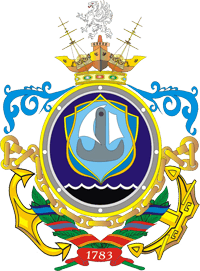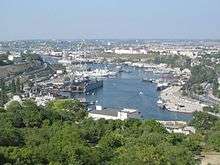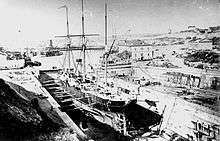Sevastopol Shipyard
Sevastopol Shipyard ( Russian: Севастопольский морской завод, Ukrainian: Севморверф, romanized: Sevmorverf, lit. 'Sevastopol Sea Wharf') is a shipyard located in Sevastopol, Crimea, founded as a dockyard for the Imperial Russian Navy in 1783.
 | |
Native name | Севастопольский морской завод |
|---|---|
| Industry | Shipbuilding |
| Founded | 1783 |
| Founder | Imperial Russian Navy |
| Headquarters | , |
| Services | Shipbuilding, Ship repair, else |
| Revenue | 400 mln R (5.8098 mln €) |
| nd (300 to 900 mln R) | |
| nd (300 to 500 mln R) | |
| Total assets | from 300 400 to 600 800 mln Rub minimum (nd) |
| Owner | AO TsS Zvezdochka (United Shipbuilding Corporation) |
Number of employees | over 600 |
| Parent | AO TsS Zvezdochka (United Shipbuilding Corporation) |
| Website | http://www.starsmz.ru |

The shipyard has mostly been used to repair and maintain warships throughout its history, although it has occasionally also built ships.
History
The Sevastopol Shipyard was founded in 1783 on the south side of Sevastopol Bay to maintain the ships of the Black Sea Fleet. It occasionally built frigates and smaller sailing ships between 1813 and 1851.[1] The Sevastopol Shipyard Lazarevskoe Admiralteystvo Ltd. company was named after Admiral Lazarev who was assigned as the general commander of the Black Sea Ports and fleet in 1834.[2] He was a major contributor to the development of the Black Sea Fleet and to the building and development of Sevastopol itself.[2] The dockyard was transferred to the Russian Steam Navigation and Trading Company in 1858 after the damage caused by the Crimean War of 1854–55 was repaired. It was nationalized on 16 August 1897.[3]
The Soviets separated it from the naval base in 1919 and named it the Sevastopol Shipyard, Engineering and Electromechanical Works (Russian: Sevastopol'skii sudostroitel'nyi, mashinostroitel'nyi i elektromekhanicheskii zavod). The dockyard was renamed the Sevastopol Naval Shipyard (Sevastopol'skii morskoi zavod) on either 13 January 1921 or January 1930. It was again renamed Shipyard No. 201 (in the name of Sergo Ordzhonikidze) on 30 December 1936 and became Shipyard in the name of Sergo Ordzhonikidze No. 201 (Zavod imeni Sergo Ordzhonikidze No. 201) on 15 May 1940.[3]
After the annexation of Crimea
Under Ukrainian law, the shipyard is part of the Sevastopol Marine Plant (Ukrainian: Севморзавод; Sevmorzavod) joint stock company (JSC). As of 2017 the shipyard is under the ownership of Zvezdochka Shipyard, a subsidiary of United Shipbuilding Corporation.[4][5] On January 31, 2018, the government of Russia transferred control of the shipyard to the Russian government under the control of the Ministry of Industry and Trade.[6][7][8]
The shipyard is building two special catamarans, each one from two barges to move on places railway and highway of Crimean Bridge arcs, also tankers and other vessels.
Facilities and Services
The shipyard operates three dry docks, a slipway for the assembly of floating crane hulls and ships, specialized shops and production sections, large warehouses, fitting-out embankments, and every other facility to secure the ship's vital systems and units.[9]
| Length | Beam | Draft | Portal crane, lifting capacity (tons) | |
|---|---|---|---|---|
| Dock #1 | 290.0 meters (951.4 ft) | 36.0 meters (118.1 ft) | 11.0 meters (36.1 ft) | 1 × 80; 1 × 10; 1 × 30; 1 × 16 |
| Dock #2 | 173.4 meters (569 ft) | 25.8 meters (85 ft) | 9.1 meters (30 ft) | 2 × 10 |
| Dock #3 | 152.0 meters (498.7 ft) | 25.8 meters (85 ft) | 8.1 meters (27 ft) | 1 × 10; 1 × 16 |
List of Products
Tankers, Fishing boats, Pontoons, Barges, Repair, else.
- Repaired Chersonesos
- Pontoons , Barges
- Repaired or float medium marine tanker ChF Iman
- Repaired many ships and boats
- Larger dry dock north east repaired or either float out two to five or six tankers or other larger vessel for the 157 and 175 meter docks.
- Inkerman dock yard repaired few and scrapped many vessels.
- Floating Docks works
Building
Pontoons and Barges related to the building of the Kerch (Strait) Bridge.
| Name | Class and type | Plant № | Laid | Launched |
|---|---|---|---|---|
| Chersonesos | Sails boat, repaired Chersonesos | nd | built 10/06/1988 at Gdansk Shipyard , repaired from 09/10 11 10/12 2015 to 11/06/2016 | |
| nd | nd | nd | nd | |
| ns | two "Catamaran" based on two Barges each , to transport Crimean Bridge Highway lanes(4 lanes, 2+2) und Railway (ZhD) (2 tracks) arcs, from Kerch site to the fairway bridge on the Sea Passage and also pontoons related to that work. | nd | most likely near or past the half 2015 through 2016 and as today since | |
| nd | nd | nd | nd |
Notes
- Tredrea & Sozaev (2010), pp. 39–40.
- Sevastopol Shipyard Website; (in Russian) Севморверф
- Harrison, et al.
- "Предприятия ОСК: Филиал "Севастопольский морской завод" АО "ЦС «Звездочка"". Oaoosk.ru. Retrieved 15 July 2017.
- Звездочка. Star.ru (in Russian). Retrieved 15 July 2017.
- "Sevmorzavod shipyard (Sevastopol) handed over to federal ownership (document)". portnews.ru. 2 February 2018. Retrieved 5 February 2018.
- "ПРАВИТЕЛЬСТВО РОССИЙСКОЙ ФЕДЕРАЦИИ РАСПОРЯЖЕНИЕ от 31 января 2018 г. No 127" (PDF). portnews.ru. Retrieved 5 February 2018.
- "Kremlin takes possession of Crimean shipyard previously owned by Ukrainian president". UAwire. 4 February 2018. Retrieved 5 February 2018.
- Sevmorverf (Sevastopol Shipyard), Federation of American Scientists Website
Bibliography
- Breyer, Siegfried (1992). Soviet Warship Development: Volume 1: 1917-1937. London: Conway Maritime Press. ISBN 0-85177-604-3.
- Harrison, Mark; Cooper, Julian; Dexter, Keith & Rodionov, Ivan (2003). The Numbered Factories and Other Establishments of the Soviet Defence Industry Complex, 1927 to 1968, Part I, Factories & Shipyards (Version 8 ed.). Warwick, UK: University of Warwick, Department of Economics.
- Polmar, Norman (1983). Guide to the Soviet Navy (3rd ed.). Annapolis, Maryland: Naval Institute Press. ISBN 0-87021-239-7.
- Tredrea, John & Sozaev, Eduard (2010). Russian Warships in the Age of Sail, 1696–1860: Design, Construction, Careers and Fates. Barnsley, UK: Seaforth Publishing. ISBN 978-1-84832-058-1.

